Estimating Air Pollution Removal and Monetary Value for Urban Green Infrastructure Strategies Using Web-Based Applications
Abstract
:1. Introduction
2. Materials and Methods
2.1. Study Area
2.2. Office for National Statistics Web-based Application
2.3. i-Tree Canopy
2.4. Comparison of the Office for National Statistics and i-Tree Canopy Tools
3. Results and Discussion
3.1. Tree Cover Results Using i-Tree Canopy
3.2. Air Pollution Removal, Monetary Value, and Tool Evaluation
3.3. Planting Strategies
4. Conclusions and Recommendations
Author Contributions
Funding
Institutional Review Board Statement
Informed Consent Statement
Data Availability Statement
Acknowledgments
Conflicts of Interest
Appendix A
| Area | A | B | C | D | E | F | |
|---|---|---|---|---|---|---|---|
| NO2 | i- Tree Canopy Version 7.1 UK | 685.52 | 594.52 | 1000.97 | 771.93 | 497.45 | 417.76 |
| i-Tree Canopy Version 6.1 US | 103.48 | 100.68 | 248.9 | 138.43 | 85.3 | 85.3 | |
| i-Tree Canopy Version 7.1 UK South West | 423.56 | 427.64 | 722.32 | 525.38 | 403.2 | 301.38 | |
| Office for National Statistics | 0 | 9.6 | 238.7 | 49.5 | 0 | 4.8 | |
| O3 | i- Tree Canopy Version 7.1 UK | 2304.31 | 1998.43 | 3364.69 | 2594.77 | 1672.16 | 1404.28 |
| i-Tree Canopy Version 6.1 US | 799.32 | 777.72 | 1920 | 1070 | 658.9 | 658.9 | |
| i-Tree Canopy Version 7.1 UK South West | 1883.35 | 1901.46 | 3211.74 | 2336.08 | 1792.81 | 1340.08 | |
| Office for National Statistics | 0 | 88 | 2685.8 | 526.5 | −8.8 | 43.5 | |
| PM2.5 | i- Tree Canopy Version 7.1 UK | 116.54 | 101.07 | 170.17 | 131.23 | 84.57 | 71.02 |
| i-Tree Canopy Version 6.1 US | 40.83 | 39.73 | 98.22 | 54.63 | 33.66 | 33.66 | |
| i-Tree Canopy Version 7.1 UK South West | 117.87 | 119 | 201 | 146.2 | 112.2 | 83.87 | |
| Office for National Statistics | 0 | 0.5 | 125 | 34.6 | −3.6 | 0.1 | |
| PM10 | i- Tree Canopy Version 7.1 UK | 465.23 | 403.48 | 679.32 | 523.88 | 337.6 | 283.52 |
| i-Tree Canopy Version 6.1 US | 226.86 | 220.73 | 545.7 | 303.51 | 187.01 | 187.01 | |
| i-Tree Canopy Version 7.1 UK South West | 422.61 | 426.68 | 720.69 | 524.2 | 402.3 | 300.71 | |
| Office for National Statistics | 0 | 0.7 | 193.9 | 55.5 | −4.3 | 0.1 | |
| SO2 | i- Tree Canopy Version 7.1 UK | 90.48 | 78.47 | 132.12 | 101.89 | 65.66 | 55.14 |
| i-Tree Canopy Version 6.1 US | 50.87 | 49.49 | 122.36 | 68.05 | 41.93 | 41.93 | |
| i-Tree Canopy Version 7.1 UK South West | 52.25 | 52.75 | 89.11 | 64.81 | 49.74 | 37.18 | |
| Office for National Statistics | 0 | 12.3 | 311.9 | 124.5 | 28.9 | 7.8 | |
References
- Ritchie, H.; Roser, M. Outdoor Air Pollution. Available online: https://ourworldindata.org/outdoor-air-pollution (accessed on 20 June 2021).
- Yim, S.H.L.; Fung, J.C.H.; Lau, A.K.H.; Kot, S.C. Air ventilation impacts of the “wall effect” resulting from the alignment of high-rise buildings. Atmos. Environ. 2009, 43, 4982–4994. [Google Scholar] [CrossRef]
- Li, Z.; Zhou, Y.; Wan, B.; Chen, Q.; Huang, B.; Cui, Y.; Chung, H. The impact of urbanization on air stagnation: Shenzhen as case study. Sci. Total Environ. 2019, 664, 347–362. [Google Scholar] [CrossRef]
- Śmiełowska, M.; Marć, M.; Zabiegała, B. Indoor air quality in public utility environments—A review. Environ. Sci. Pollut. Res. 2017, 24, 11166–11176. [Google Scholar] [CrossRef] [Green Version]
- Peters, A.; Dockery, D.W.; Muller, J.E.; Mittleman, M.A. Increased Particulate Air Pollution and the Triggering of Myocardial Infarction. Circulation 2001, 103, 2810–2815. [Google Scholar] [CrossRef] [Green Version]
- WHO World Health Assembly Closes, Passing Resolutions on Air Pollution and Epilepsy. Available online: https://apps.who.int/mediacentre/news/releases/2015/wha-26-may-2015/en/index.html (accessed on 15 July 2021).
- Royal College of Physicians. Every Breath We Take: The Lifelong Impact of Air Pollution; Royal College of Physicians: London, UK, 2016. [Google Scholar]
- Abhijith, K.V.; Kumar, P.; Gallagher, J.; McNabola, A.; Baldauf, R.; Pilla, F.; Broderick, B.; Di Sabatino, S.; Pulvirenti, B. Air pollution abatement performances of green infrastructure in open road and built-up street canyon environments—A review. Atmos. Environ. 2017, 162, 71–86. [Google Scholar] [CrossRef]
- Kumar, P.; Druckman, A.; Gallagher, J.; Gatersleben, B.; Allison, S.; Eisenman, T.S.; Hoang, U.; Hama, S.; Tiwari, A.; Sharma, A.; et al. The nexus between air pollution, green infrastructure and human health. Environ. Int. 2019, 133, 105181. [Google Scholar] [CrossRef]
- Hewitt, C.N.; Ashworth, K.; MacKenzie, A.R. Using green infrastructure to improve urban air quality (GI4AQ). Ambio 2020, 49, 62–73. [Google Scholar] [CrossRef] [PubMed] [Green Version]
- Russo, A.; Cirella, G.T. Urban Sustainability: Integrating Ecology in City Design and Planning. In Sustainable Human–Nature Relations: Environmental Scholarship, Economic Evaluation, Urban Strategies; Cirella, G.T., Ed.; Springer: Singapore, 2020; pp. 187–204. [Google Scholar]
- Jim, C.Y.; Chen, W.Y. Assessing the ecosystem service of air pollutant removal by urban trees in Guangzhou (China). J. Environ. Manag. 2008, 88, 665–676. [Google Scholar] [CrossRef]
- Cavanagh, J.-A.E.; Zawar-Reza, P.; Wilson, J.G. Spatial attenuation of ambient particulate matter air pollution within an urbanised native forest patch. Urban For. Urban Green. 2009, 8, 21–30. [Google Scholar] [CrossRef]
- Dadea, C.; Russo, A.; Tagliavini, M.; Mimmo, T.; Zerbe, S. Tree Species as Tools for Biomonitoring and Phytoremediation in Urban Environments: A Review with Special Regard to Heavy Metals. Arboric. Urban For. 2017, 43, 155–167. [Google Scholar]
- Brancalion, P.H.S.; Holl, K.D. Guidance for successful tree planting initiatives. J. Appl. Ecol. 2020, 57, 2349–2361. [Google Scholar] [CrossRef]
- Pynnönen, S.; Haltia, E.; Hujala, T. Digital forest information platform as service innovation: Finnish Metsaan.fi service use, users and utilisation. For. Policy Econ. 2021, 125, 102404. [Google Scholar] [CrossRef]
- Jones, B.A. Planting urban trees to improve quality of life? The life satisfaction impacts of urban afforestation. For. Policy Econ. 2021, 125, 102408. [Google Scholar] [CrossRef]
- TDAG. Trees in the Townscape: A Guide for Decision Makers; Trees and Design Action Group: London, UK, 2012. [Google Scholar]
- Mullaney, J.; Lucke, T.; Trueman, S.J. A review of benefits and challenges in growing street trees in paved urban environments. Landsc. Urban Plan. 2015, 134, 157–166. [Google Scholar] [CrossRef]
- Bodnaruk, E.W.; Kroll, C.N.; Yang, Y.; Hirabayashi, S.; Nowak, D.J.; Endreny, T.A. Where to plant urban trees? A spatially explicit methodology to explore ecosystem service tradeoffs. Landsc. Urban Plan. 2017, 157, 457–467. [Google Scholar] [CrossRef] [Green Version]
- Urban, J. Up by Roots; ISA: New York, NY, USA, 2008; ISBN 1881956652. [Google Scholar]
- Jerome, G.; Sinnett, D.; Burgess, S.; Calvert, T.; Mortlock, R. A framework for assessing the quality of green infrastructure in the built environment in the UK. Urban. For. Urban. Green. 2019, 40, 174–182. [Google Scholar] [CrossRef]
- Ellis, J.B. Sustainable surface water management and green infrastructure in UK urban catchment planning. J. Environ. Plan. Manag. 2013, 56, 24–41. [Google Scholar] [CrossRef]
- Joint Core Strategy. Green Infrastructure Strategy; Joint Core Strategy: Gloucester, UK, 2014.
- Natural England. Green Infrastructure Strategies: An Introduction for Local Authorities and Their Partners; Natural England: London, UK, 2008.
- Russo, A.; Escobedo, F.J.; Timilsina, N.; Schmitt, A.O.; Varela, S.; Zerbe, S. Assessing urban tree carbon storage and sequestration in Bolzano, Italy. Int. J. Biodivers. Sci. Ecosyst. Serv. Manag. 2014, 10, 54–70. [Google Scholar] [CrossRef]
- Daily, G.; Polasky, S.; Goldstein, J.; Kareiva, P.; Mooney, H. Ecosystem services in decision making: Time to deliver. Front. Ecol. Environ. 2009, 7, 21–28. [Google Scholar] [CrossRef] [Green Version]
- Villa, F.; Bagstad, K.J.; Voigt, B.; Johnson, G.W.; Portela, R.; Honzák, M.; Batker, D. A Methodology for Adaptable and Robust Ecosystem Services Assessment. PLoS ONE 2014, 9, e91001. [Google Scholar] [CrossRef]
- Brown, M.E.; McGroddy, M.; Spence, C.; Flake, L.; Sarfraz, A.; Nowak, D.J.; Milesi, C. Modeling the Ecosystem Services Provided by Trees in Urban Ecosystems: Using Biome-BGC to Improve i-Tree Eco; NASA: Washington, DC, USA, 2012.
- Nowak, D.J. Understanding i-Tree: Summary of Programs and Methods; General Technical Report NRS-200; Northern Research Station, Forest Service, Department of Agriculture: Madison, WI, USA, 2020; 100p, [plus 14 appendices].
- Roy, S.; Byrne, J.; Pickering, C. A systematic quantitative review of urban tree benefits, costs, and assessment methods across cities in different climatic zones. Urban For. Urban Green. 2012, 11, 351–363. [Google Scholar] [CrossRef] [Green Version]
- Rogers, K.; Hansford, D.; Sunderland, T.; Brunt, A.; Coish, N. Measuring the ecosystem services of Torbay’s trees: The Torbay i-Tree Eco pilot project. In Proceedings of the Urban Trees Research Conference, London, UK, 26–27 July 2021; Forestry Commission: Edinburgh, UK, 2011; pp. 18–26. [Google Scholar]
- Raum, S.; Hand, K.L.; Hall, C.; Edwards, D.M.; O’Brien, L.; Doick, K.J. Achieving impact from ecosystem assessment and valuation of urban greenspace: The case of i-Tree Eco in Great Britain. Landsc. Urban Plan. 2019, 190, 103590. [Google Scholar] [CrossRef]
- Natural England. Green Infrastructure—Valuation Tools Assessment; Natural England: Exeter, UK, 2013.
- Greater London Authority. A Natural Capital Account for Public Green Space in London: How It Can Shape Future Policy and Decision-Making. Available online: https://www.london.gov.uk/sites/default/files/nca_supplementary_document.pdf (accessed on 14 July 2021).
- UK Government. The England Trees Action Plan. 2021–2024; UK Government: London, UK, 2021.
- Pincetl, S.; Gillespie, T.; Pataki, D.E.; Saatchi, S.; Saphores, J.-D. Urban tree planting programs, function or fashion? Los Angeles and urban tree planting campaigns. GeoJournal 2013, 78, 475–493. [Google Scholar] [CrossRef]
- Bristol City Council. The Population of Bristol; Bristol City Council: Bristol, UK, 2019.
- Climate Action. Friends of the Earth Bristol’s One City Plan to Create an Urban Forest. 2021. Available online: https://takeclimateaction.uk/solutions/bristols-one-city-plan-create-urban-forest (accessed on 1 June 2021).
- Consultants Air Quality. Health Impacts of Air Pollution; Consultants Air Quality: Bristol, UK, 2017. [Google Scholar]
- Chan, W.T. The Benefit of Green Infrastructure on Air Quality in Bristol; University of Gloucestershire: Cheltenham, UK, 2019. [Google Scholar]
- Garrett, J.; Connett, J. Campaigners Accuse Marvin Rees of Not Protecting Bristol’s Mature Trees. Available online: https://thebristolcable.org/2021/02/campaigners-accuse-marvin-rees-of-putting-housing-above-climate-by-not-protecting-bristols-mature-trees/ (accessed on 14 July 2021).
- Office for National Statistics UK Air Pollution Removal: How Much Pollution Does Vegetation Remove in Your Area? Available online: https://www.ons.gov.uk/economy/environmentalaccounts/articles/ukairpollutionremovalhowmuchpollutiondoesvegetationremoveinyourarea/2018-07-30 (accessed on 16 June 2021).
- Jones, L.; Vieno, M.; Fitch, A.; Carnell, E.; Steadman, C.; Cryle, P.; Holland, M.; Nemitz, E.; Morton, D.; Hall, J.; et al. Urban natural capital accounts: Developing a novel approach to quantify air pollution removal by vegetation. J. Environ. Econ. Policy 2019, 8, 413–428. [Google Scholar] [CrossRef] [Green Version]
- Vieno, M.; Heal, M.R.; Williams, M.L.; Carnell, E.J.; Nemitz, E.; Stedman, J.R.; Reis, S. The sensitivities of emissions reductions for the mitigation of UK PM2.5. Atmos. Chem. Phys. 2016, 16, 265–276. [Google Scholar] [CrossRef] [Green Version]
- Jones, L.; Vieno, M.; Morton, D.; Cryle, P.; Holland, M.; Carnell, E.; Nemitz, E.; Hall, J.; Beck, R.; Reis, S.; et al. Developing Estimates for the Valuation of Air Pollution Removal in Ecosystem Accounts: Final Report Office for National Statistics; Centre for Ecology and Hydrology (CEH): Wallingford, UK, 2017. [Google Scholar]
- Nowak, D.J.; Greenfield, E.J. Tree and impervious cover change in U.S. cities. Urban For. Urban Green. 2012, 11, 21–30. [Google Scholar] [CrossRef] [Green Version]
- Russo, A.; Escobedo, F.J.; Timilsina, N.; Zerbe, S. Transportation carbon dioxide emission offsets by public urban trees: A case study in Bolzano, Italy. Urban For. Urban Green. 2015, 14, 398–403. [Google Scholar] [CrossRef]
- Hirabayashi, S. i-Tree Canopy Air Pollutant Removal and Monetary Value Model Descriptions. 2014, pp. 1–11. Available online: https://www.itreetools.org/documents/560/i-Tree_Canopy_Air_Pollutant_Removal_and_Monetary_Value_Model_Descriptions.pdf (accessed on 10 June 2021).
- Tree i-Tree Species. Available online: https://species.itreetools.org/ (accessed on 15 June 2021).
- Trees of Bristol Bristol Tree Canopy Cover Survey. 2018. Available online: https://bristoltrees.space/trees/treecover-map.xq?fbclid=IwAR1QpV-CYSE6LYwZjd5yak_S3QZpoqBqILnj7_O3-SdzmTtBwwhbdg9dgcA (accessed on 16 June 2021).
- Rogers, K.; Jaluzot, A. Treeconomics Oxford i-Tree Canopy Cover Assessment; Treeconomics: Oxford, UK, 2015. [Google Scholar]
- Doick, K.J.; Davies, H.J.; Moss, J.; Coventry, R.; Handley, P.; VazMonteiro, M.; Rogers, K.; Simpkin, P. The Canopy Cover of England’s Towns and Cities: Baselining and setting targets to improve human health and well-being. In Proceedings of the Trees, People and the Built Environment 3: Urban Trees Research Conference, Birmingham, UK, 5–6 April 2017. [Google Scholar]
- Kenney, W.A.; Van Wassenaer, P.J.E.; Satel, A.L. Criteria and indicators for strategic urban forest planning and management. Arboric. Urban For. 2011, 37, 108–117. [Google Scholar]
- Astell-Burt, T.; Feng, X. Association of Urban Green Space with Mental Health and General Health among Adults in Australia. JAMA Netw. Open 2019, 2, 1–22. [Google Scholar] [CrossRef] [Green Version]
- Marselle, M.R.; Bowler, D.E.; Watzema, J.; Eichenberg, D.; Kirsten, T.; Bonn, A. Urban street tree biodiversity and antidepressant prescriptions. Sci. Rep. 2020, 10, 22445. [Google Scholar] [CrossRef]
- Kondo, M.C.; Mueller, N.; Locke, D.H.; Roman, L.A.; Rojas-Rueda, D.; Schinasi, L.H.; Gascon, M.; Nieuwenhuijsen, M.J. Health impact assessment of Philadelphia’s 2025 tree canopy cover goals. Lancet Planet. Health 2020, 4, e149–e157. [Google Scholar] [CrossRef]
- Nemitz, E.; Vieno, M.; Carnell, E.; Fitch, A.; Steadman, C.; Cryle, P.; Holland, M.; Morton, R.D.; Hall, J.; Mills, G.; et al. Potential and limitation of air pollution mitigation by vegetation and uncertainties of deposition-based evaluations. Philos. Trans. R. Soc. A Math. Phys. Eng. Sci. 2020, 378, 20190320. [Google Scholar] [CrossRef] [PubMed]
- Nowak, D.J.; Hirabayashi, S.; Bodine, A.; Greenfield, E. Tree and forest effects on air quality and human health in the United States. Environ. Pollut. 2014, 193, 119–129. [Google Scholar] [CrossRef] [Green Version]
- Troy, A.; Morgan Grove, J.; O’Neil-Dunne, J. The relationship between tree canopy and crime rates across an urban–rural gradient in the greater Baltimore region. Landsc. Urban Plan. 2012, 106, 262–270. [Google Scholar] [CrossRef]
- Pugh, T.A.M.; MacKenzie, A.R.; Whyatt, J.D.; Hewitt, C.N. Effectiveness of Green Infrastructure for Improvement of Air Quality in Urban Street Canyons. Environ. Sci. Technol. 2012, 46, 7692–7699. [Google Scholar] [CrossRef] [PubMed] [Green Version]
- Tree. i-Tree Canopy Technical Notes. Available online: https://canopy.itreetools.org/references (accessed on 16 June 2021).
- Sunderland, T.; Rogers, K.; Coish, N. What proportion of the costs of urban trees can be justified by the carbon sequestration and air-quality benefits they provide? Arboric. J. 2012, 34, 62–82. [Google Scholar] [CrossRef]
- Janhäll, S. Review on urban vegetation and particle air pollution—Deposition and dispersion. Atmos. Environ. 2015, 105, 130–137. [Google Scholar] [CrossRef]
- Jeanjean, A.P.R.; Buccolieri, R.; Eddy, J.; Monks, P.S.; Leigh, R.J. Air quality affected by trees in real street canyons: The case of Marylebone neighbourhood in central London. Urban For. Urban Green. 2017, 22, 41–53. [Google Scholar] [CrossRef]
- Riondato, E.; Pilla, F.; Sarkar Basu, A.; Basu, B. Investigating the effect of trees on urban quality in Dublin by combining air monitoring with i-Tree Eco model. Sustain. Cities Soc. 2020, 61, 102356. [Google Scholar] [CrossRef]
- Barwise, Y.; Kumar, P. Designing vegetation barriers for urban air pollution abatement: A practical review for appropriate plant species selection. NPJ Clim. Atmos. Sci. 2020, 3, 12. [Google Scholar] [CrossRef] [Green Version]
- Hirons, A.; Sjöman, H. Tree Species Selection for Green Infrastructure: A Guide for Specifiers; Trees and Design Action Group: London, UK, 2019; ISBN 978-0-9928686-4-2. [Google Scholar]
- Wu, C.; Xiao, Q.; McPherson, E.G. A method for locating potential tree-planting sites in urban areas: A case study of Los Angeles, USA. Urban For. Urban Green. 2008, 7, 65–76. [Google Scholar] [CrossRef]
- Jim, C.Y.; Konijnendijk van den Bosch, C.; Chen, W.Y. Acute Challenges and Solutions for Urban Forestry in Compact and Densifying Cities. J. Urban Plan. Dev. 2018, 144, 04018025. [Google Scholar] [CrossRef]
- Vaz Monteiro, M.; Handley, P.; Morison, J.; Doick, K. The Role of Urban Trees and Greenspaces in Reducing Urban Air Temperatures; Forest Research: Surrey, UK, 2019; ISBN 978-0-85538-984-0. [Google Scholar]
- Defra Air Quality Expert Group—Defra, UK. Available online: https://uk-air.defra.gov.uk/research/aqeg/ (accessed on 20 June 2021).
- Miranda, M.L.; Edwards, S.E.; Keating, M.H.; Paul, C.J. Making the environmental justice grade: The relative burden of air pollution exposure in the United States. Int. J. Environ. Res. Public Health 2011, 8, 1755–1771. [Google Scholar] [CrossRef] [PubMed]
- Duvall, R.M.; Long, R.W.; Beaver, M.R.; Kronmiller, K.G.; Wheeler, M.L.; Szykman, J.J. Performance evaluation and community application of low-cost sensors for ozone and nitrogen dioxide. Sensors 2016, 16, 1698. [Google Scholar] [CrossRef]
- Stevens, K.A.; Bryer, T.A.; Yu, H. Air Quality Enhancement Districts: Democratizing data to improve respiratory health. J. Environ. Stud. Sci. 2021, 1–6. [Google Scholar] [CrossRef]
- Yao, N.; Konijnendijk van den Bosch, C.C.; Yang, J.; Devisscher, T.; Wirtz, Z.; Jia, L.; Duan, J.; Ma, L. Beijing’s 50 million new urban trees: Strategic governance for large-scale urban afforestation. Urban For. Urban Green. 2019, 44, 126392. [Google Scholar] [CrossRef]
- Timilsina, N.; Beck, J.L.; Eames, M.S.; Hauer, R.; Werner, L. A comparison of local and general models of leaf area and biomass of urban trees in USA. Urban For. Urban Green. 2017, 24, 157–163. [Google Scholar] [CrossRef] [Green Version]
- Sacre, K. i-Tree focus Tree planting strategies. ARB Mag. 2020, 190, 15–16. [Google Scholar]
- Parmehr, E.G.; Amati, M.; Taylor, E.J.; Livesley, S.J. Estimation of urban tree canopy cover using random point sampling and remote sensing methods. Urban For. Urban Green. 2016, 20, 160–171. [Google Scholar] [CrossRef]
- Omodior, O.; Eze, P.; Anderson, K.R. Using i-tree canopy vegetation cover subtype classification to predict peri-domestic tick presence. Ticks Tick Borne Dis. 2021, 12, 101684. [Google Scholar] [CrossRef]
- Russo, A.; Cirella, G.T. Edible urbanism 5.0. Palgrave Commun. 2019, 5, 1–9. [Google Scholar] [CrossRef]
- Prasad, A.; Gray, C.B.; Ross, A.; Kano, M. Metrics in Urban Health: Current Developments and Future Prospects. Annu. Rev. Public Health 2016, 37, 113–133. [Google Scholar] [CrossRef] [Green Version]
- Grubesic, T.H.; Matisziw, T.C. On the use of ZIP codes and ZIP code tabulation areas (ZCTAs) for the spatial analysis of epidemiological data. Int. J. Health Geogr. 2006, 5, 1–15. [Google Scholar] [CrossRef] [Green Version]
- Krieger, N.; Waterman, P.; Chen, J.T.; Soobader, M.J.; Subramanian, S.V.; Carson, R. Zip code caveat: Bias due to spatiotemporal mismatches between zip codes and US census-defined geographic areas: The public health disparities geocoding project. Am. J. Public Health 2002, 92, 1100–1102. [Google Scholar] [CrossRef]
- Acevedo-Garcia, D. Zip code-level risk factors for tuberculosis: Neighborhood environment and residential segregation in New Jersey, 1985–1992. Am. J. Public Health 2001, 91, 734–741. [Google Scholar] [CrossRef] [Green Version]
- Liu, O.Y.; Russo, A. Assessing the contribution of urban green spaces in green infrastructure strategy planning for urban ecosystem conditions and services. Sustain. Cities Soc. 2021, 68, 102772. [Google Scholar] [CrossRef]
- Dales, N.P.; Brown, N.J.; Lusardi, J. Assessing the Potential for Mapping Ecosystem Services in England Based on Existing Habitats; Natural England: Newcastle, UK, 2014.
- Baró, F.; Gómez-Baggethun, E.; Haase, D. Ecosystem service bundles along the urban-rural gradient: Insights for landscape planning and management. Ecosyst. Serv. 2017, 24, 147–159. [Google Scholar] [CrossRef] [Green Version]
- Zardo, L.; Geneletti, D.; Pérez-Soba, M.; Van Eupen, M. Estimating the cooling capacity of green infrastructures to support urban planning. Ecosyst. Serv. 2017, 26, 225–235. [Google Scholar] [CrossRef]
- Larondelle, N.; Haase, D. Urban ecosystem services assessment along a rural–urban gradient: A cross-analysis of European cities. Ecol. Indic. 2013, 29, 179–190. [Google Scholar] [CrossRef]
- Lin, J.; Kroll, C.N.; Nowak, D.J. An uncertainty framework for i-Tree eco: A comparative study of 15 cities across the United States. Urban For. Urban Green. 2021, 60, 127062. [Google Scholar] [CrossRef]
- Russo, A.; Escobedo, F.J.; Cirella, G.T.; Zerbe, S. Edible green infrastructure: An approach and review of provisioning ecosystem services and disservices in urban environments. Agric. Ecosyst. Environ. 2017, 242, 53–66. [Google Scholar] [CrossRef]
- Von Döhren, P.; Haase, D. Ecosystem disservices research: A review of the state of the art with a focus on cities. Ecol. Indic. 2015, 52, 490–497. [Google Scholar] [CrossRef]
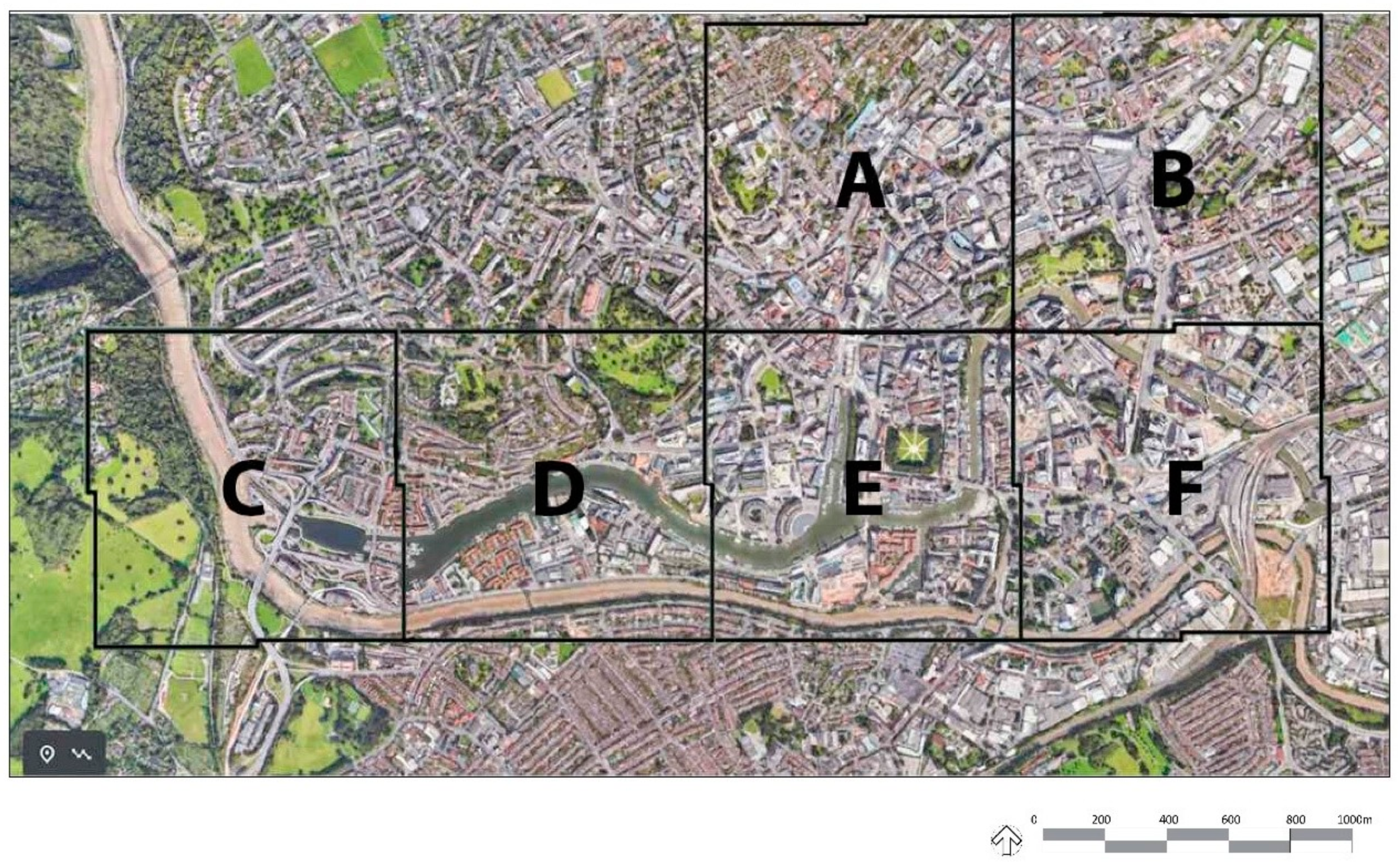
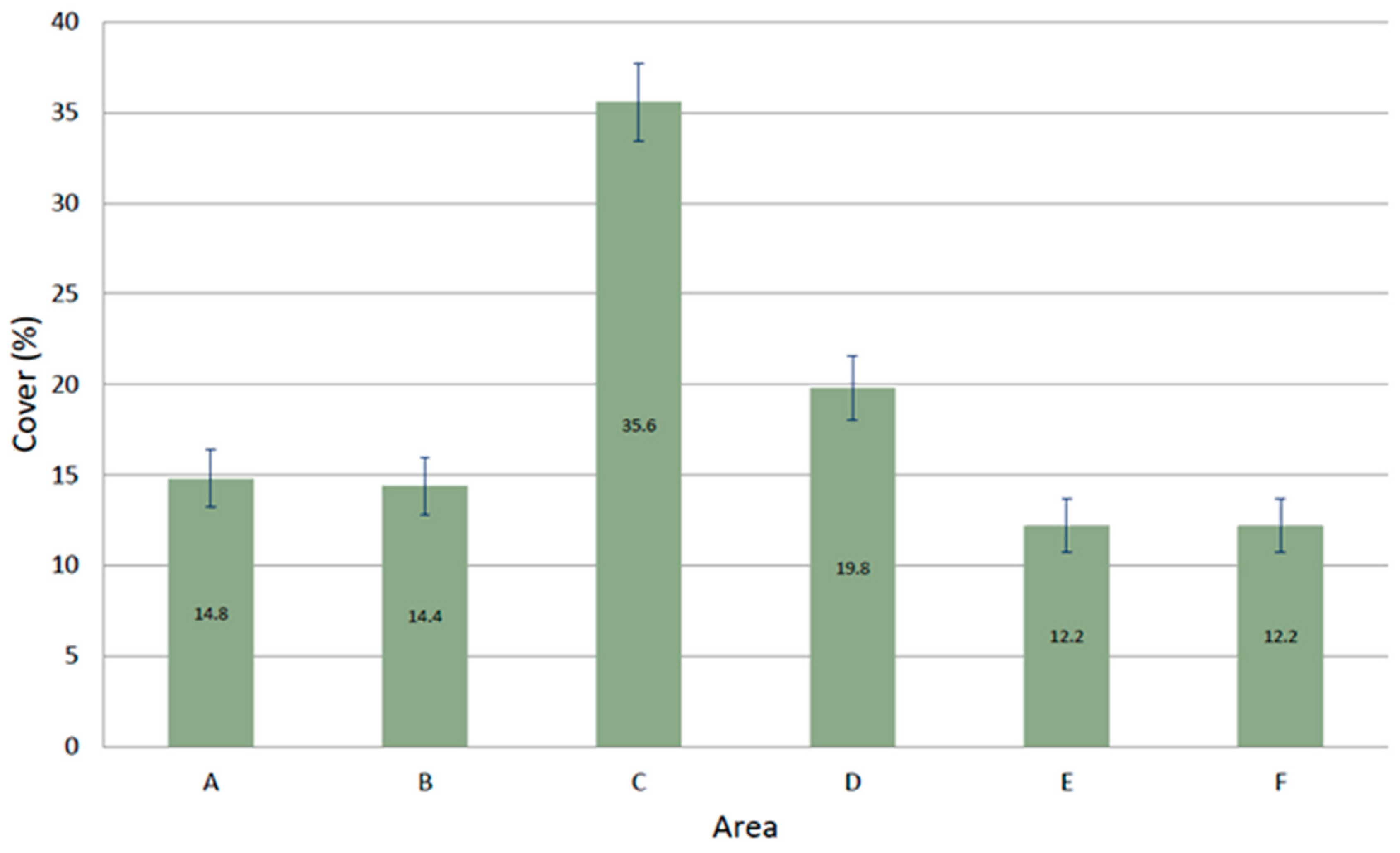
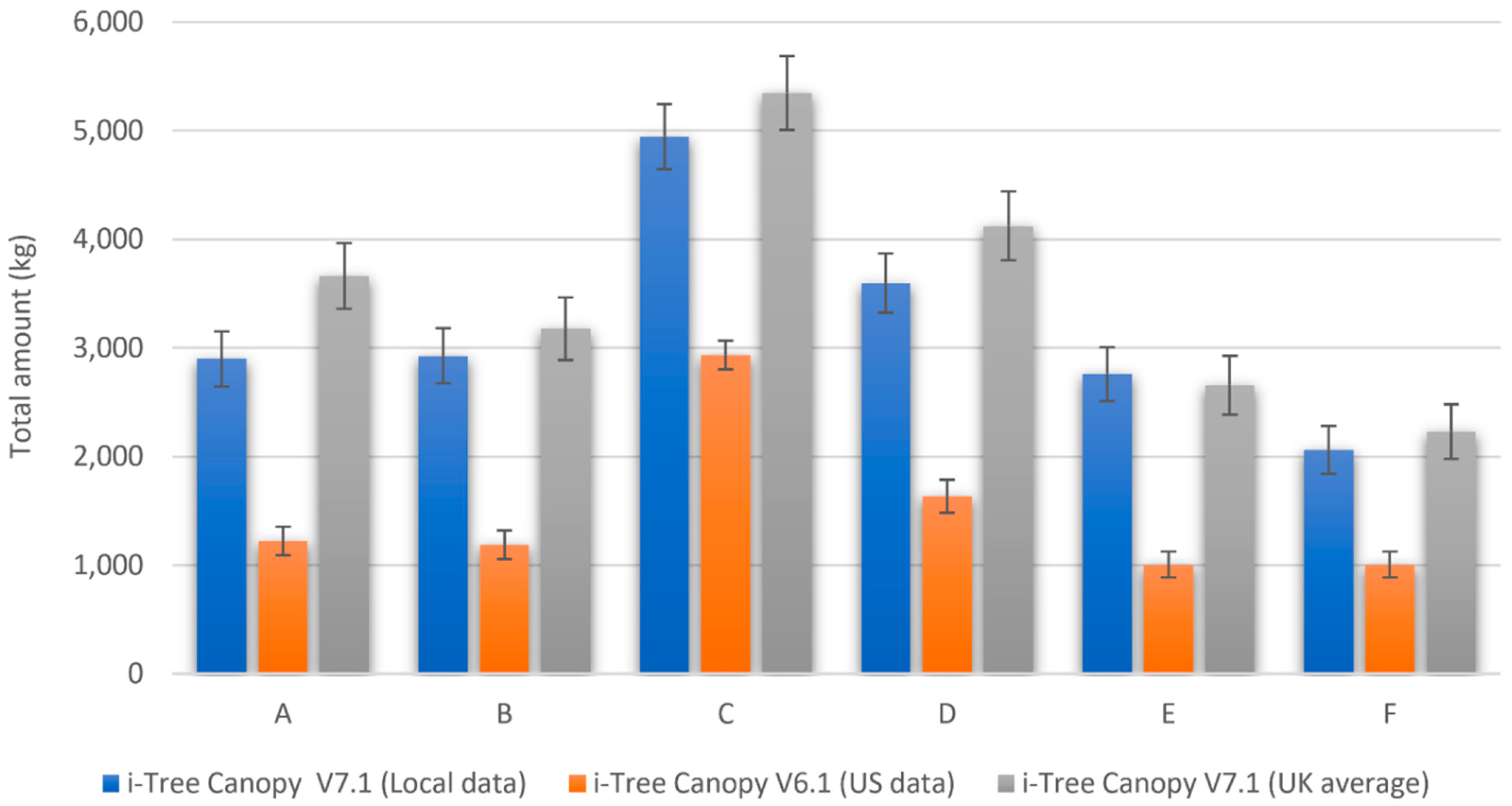
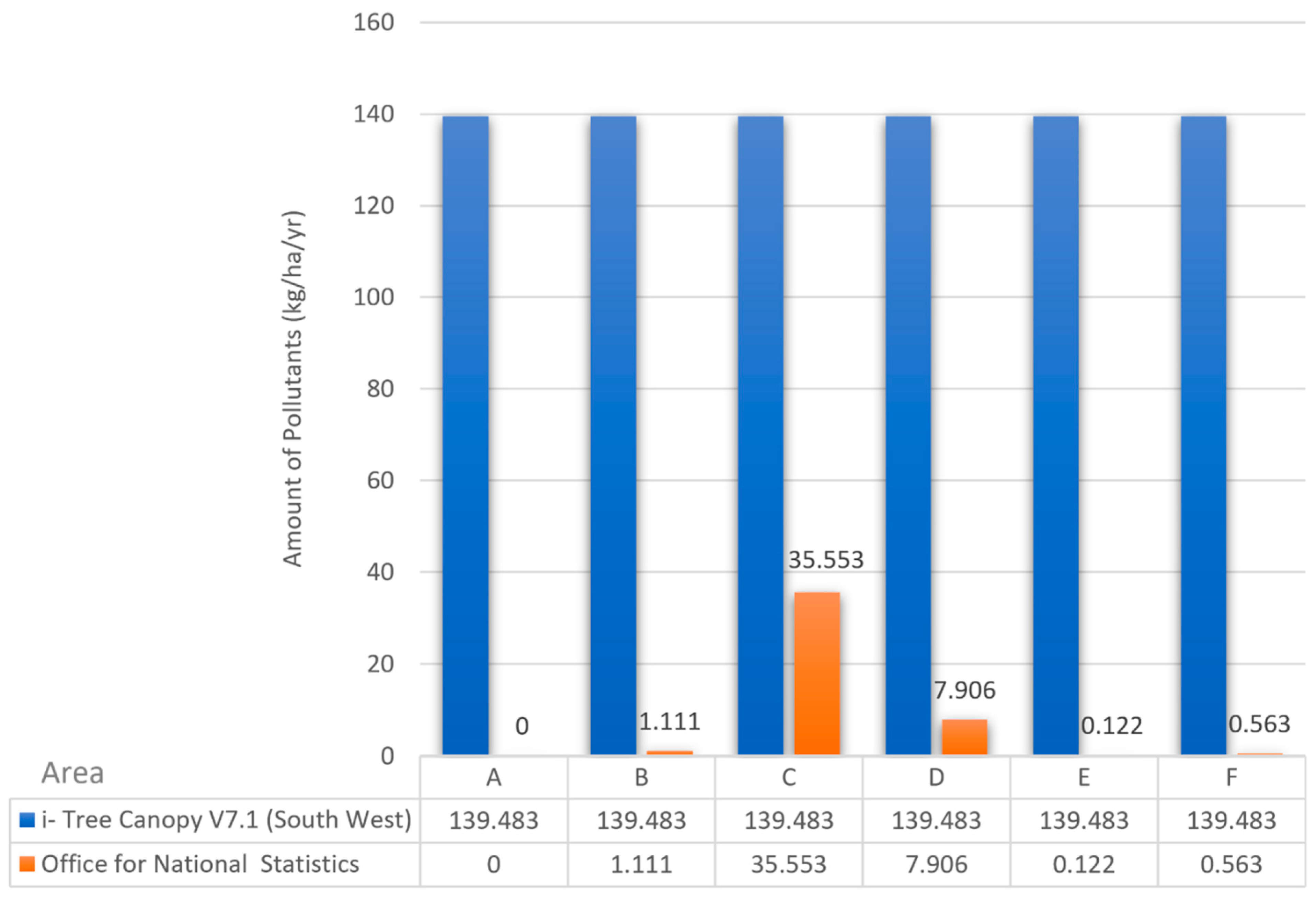
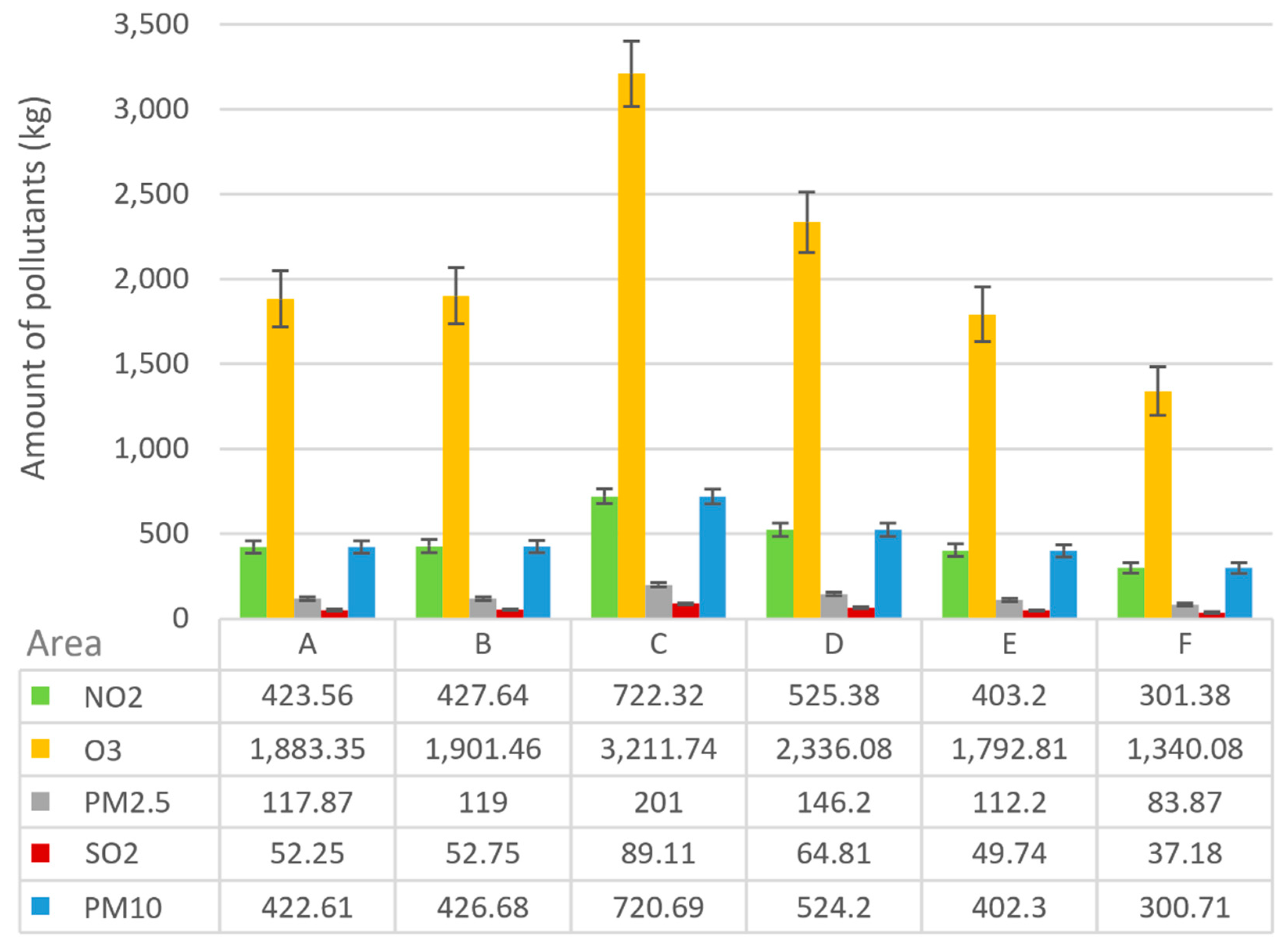
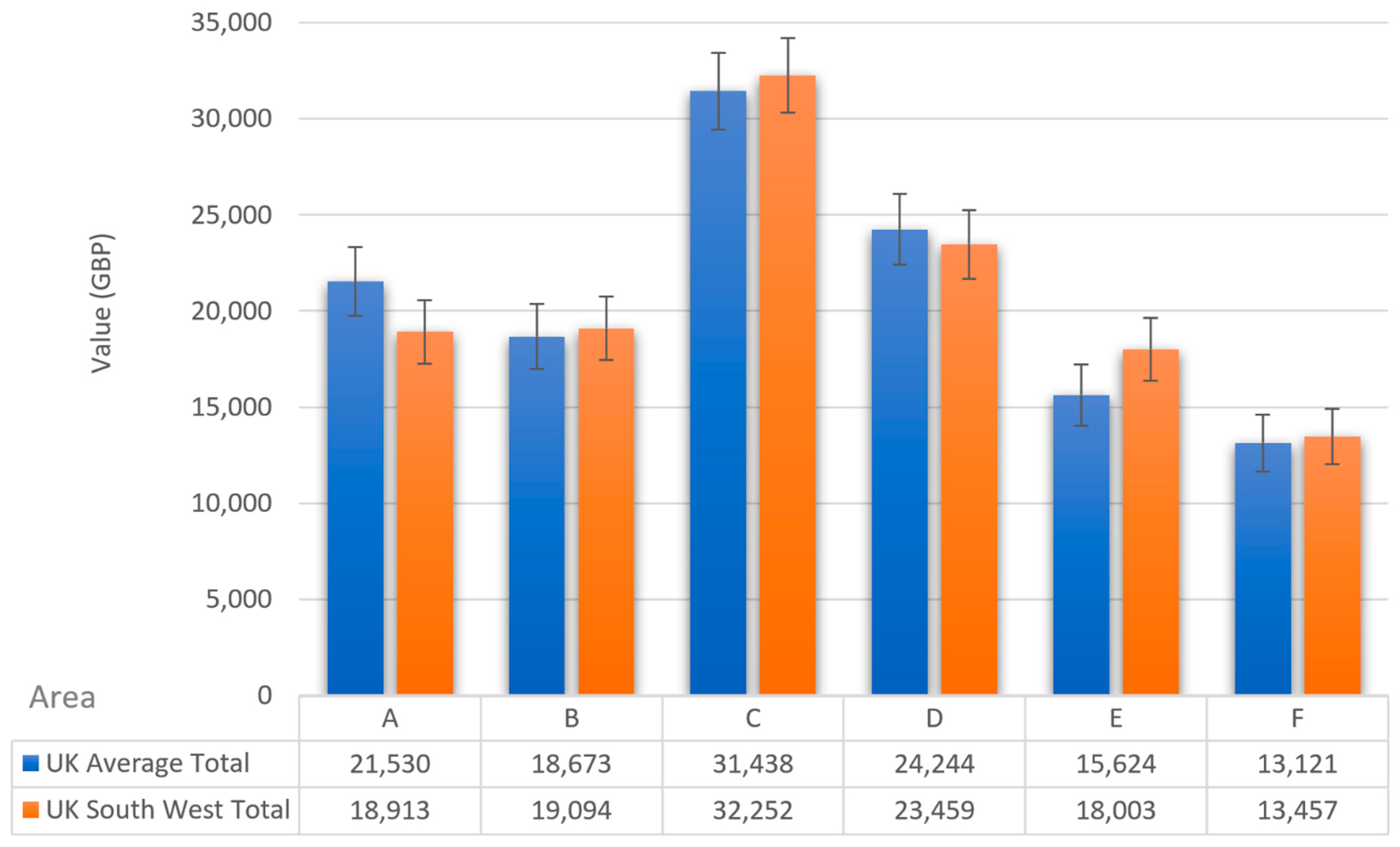

| Pollutant | UGBI † | Year 2015 |
|---|---|---|
| Urban trees and woodland | 1.23 | |
| PM10 | Urban grassland | 1.45 |
| Urban water | −0.004 | |
| Urban trees and woodland | 0.70 | |
| PM2.5 | Urban grassland | 0.31 |
| Urban water | −0.003 | |
| Urban trees and woodland | 0.59 | |
| SO2 | Urban grassland | 1.00 |
| Urban water | −0.049 | |
| Urban trees and woodland | 0.44 | |
| NH3 | Urban grassland | 0.95 |
| Urban water | −0.045 | |
| Urban trees and woodland | 0.41 | |
| NO2 | Urban grassland | 1.61 |
| Urban water | 0.000 | |
| Urban trees and woodland | 4.97 | |
| O3 | Urban grassland | 16.94 |
| Urban water | −0.003 |
| Pollutant | Removal Rate (g/m²/Year) * | Monetary Value (GBP/t/Year) * | Removal Rate (g/m²/Year) ** | Monetary Value (GBP/t/Year) ** |
|---|---|---|---|---|
| CO | 0.148 | 956.63 | 0.072 | 956.63 |
| NO2 | 3.065 | 187.91 | 2.037 | 114.41 |
| O3 | 10.304 | 928.15 | 9.06 | 770.40 |
| PM10 | 2.08 | 33,713.00 | 2.033 | 33,713.00 |
| PM2.5 | 0.521 | 30,654.87 | 0.567 | 26,838.42 |
| SO2 | 0.405 | 64.93 | 0.251 | 41.56 |
Publisher’s Note: MDPI stays neutral with regard to jurisdictional claims in published maps and institutional affiliations. |
© 2021 by the authors. Licensee MDPI, Basel, Switzerland. This article is an open access article distributed under the terms and conditions of the Creative Commons Attribution (CC BY) license (https://creativecommons.org/licenses/by/4.0/).
Share and Cite
Russo, A.; Chan, W.T.; Cirella, G.T. Estimating Air Pollution Removal and Monetary Value for Urban Green Infrastructure Strategies Using Web-Based Applications. Land 2021, 10, 788. https://doi.org/10.3390/land10080788
Russo A, Chan WT, Cirella GT. Estimating Air Pollution Removal and Monetary Value for Urban Green Infrastructure Strategies Using Web-Based Applications. Land. 2021; 10(8):788. https://doi.org/10.3390/land10080788
Chicago/Turabian StyleRusso, Alessio, Wing Tung Chan, and Giuseppe T. Cirella. 2021. "Estimating Air Pollution Removal and Monetary Value for Urban Green Infrastructure Strategies Using Web-Based Applications" Land 10, no. 8: 788. https://doi.org/10.3390/land10080788
APA StyleRusso, A., Chan, W. T., & Cirella, G. T. (2021). Estimating Air Pollution Removal and Monetary Value for Urban Green Infrastructure Strategies Using Web-Based Applications. Land, 10(8), 788. https://doi.org/10.3390/land10080788








